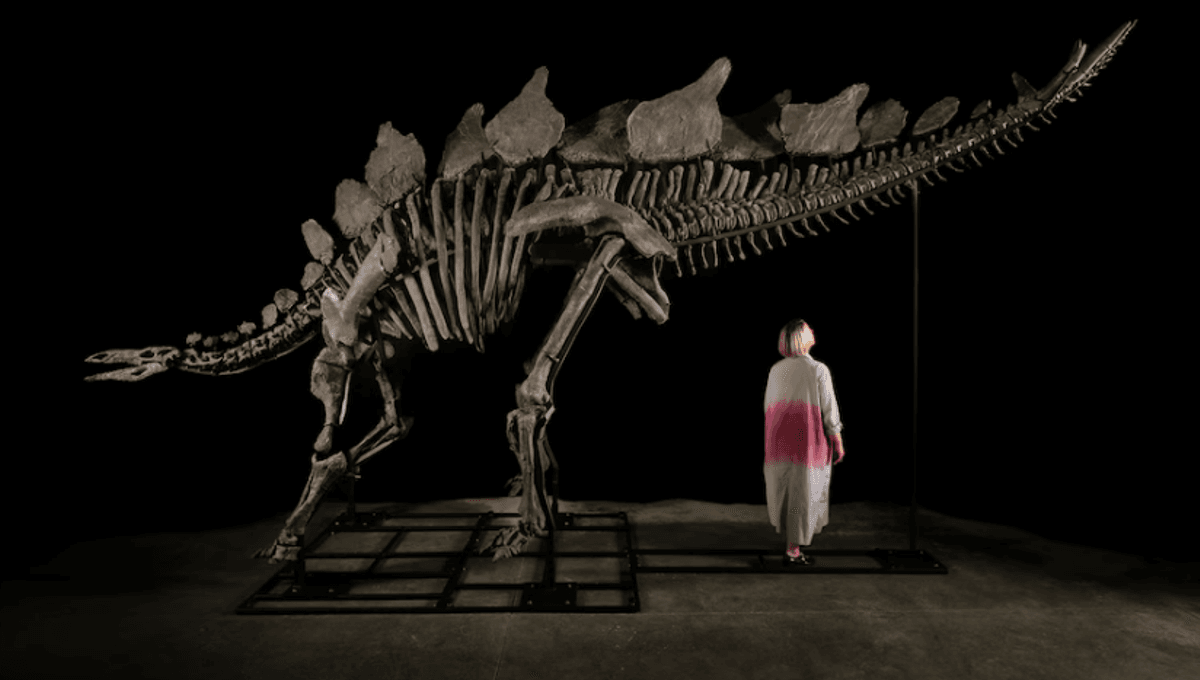
After less than an hour and a half of bidding, the remains of a Stegosaurus dubbed “Apex” sold for a whopping $44.6 million at Sotheby’s on Wednesday, making it the most expensive fossil ever to have been sold at auction.
The successful bidder was American hedge fund manager and multi-billionaire Kenneth Griffin, who doesn’t seem to mind splashing the cash on pricey historical items, having nabbed a first-edition copy of the US Constitution for $43.2 million back in 2021.
It’s not exactly unusual for a lot of money to be thrown about at a Sotheby’s auction, but the sale of Apex certainly surpassed expectations.
The previous title holder for the most valuable fossil sold at auction was Stan the Tyrannosaurus rex, who went for $31.8 million. Seemingly not expecting history to repeat itself, let alone go far beyond it, auctioneers set a relatively conservative estimate of $4 to 6 million for Apex.
Some may not be surprised that the Stegosaurus beat out the T. rex (at least in monetary terms, you wouldn’t see them in an actual fight because they didn’t live at the same time), because Apex is quite the specimen.
Uncovered, quite amusingly, near the town of Dinosaur in Colorado, Apex is believed to be one of the most intact Stegosaurus specimens of its size, at over 3 meters (11 feet) tall and around 8 meters (nearly 27 feet) long.
The question many people are asking, however, is whether or not fossils with such potential scientific value should be allowed to be sold off to the highest bidder.
“I don’t think fossils should be allowed to be auctioned,” palaeontologist Dr Cary Woodruff, the Curator of Vertebrate Paleontology at Frost Science, told NPR. “And these auctions really continue to deepen the divide between what we would consider academic and commercial paleontology.”
That concern seems to have been picked up on by those who sold Apex, with the listing for the dinosaur noting that whoever ended up buying the specimen would also get all of its 3D scan data, to “allow primary information about the dinosaur to remain with the specimen and promote collaboration in future research and education,” as reported by Smithsonian Magazine.
There’s also the matter of cost – lots of scientific institutions and museums simply don’t have the funding to drop nearly $45 million on a single specimen.
“We have no chance,” Diego C. García-Bellido, a senior researcher of palaeontology at the South Australian Museum, told The Washington Post in May.
“Science cannot compete with private companies [or wealthy buyers] in terms of getting their hands on a specimen. I know how strapped for cash, in general, museums are. … Five or 6 million dollars is the sort of money that almost no museum in the world can afford to pay,” García-Bellido, who’s also a professor at the University of Adelaide, continued.
But that doesn’t always mean that scientifically valuable specimens stay in the hands of those who purchase them.
“Losing scientifically important fossils to a private collection is a concern often mentioned, but in our experience, we have yet to see it materialize,” Sotheby’s Senior Vice President and Global Head of Science and Pop Culture Cassandra Hatton told NPR. “We find that clients overwhelmingly purchase specimens either for museums or donate them.”
Stan, for example, is due to be put on display in Abu Dhabi’s new natural history museum and Apex looks set to end up in a similar home, albeit one closer to where the dino was found. After Wednesday’s auction, the Wall Street Journal reported that Griffin aimed to lend his new dinosaur to a US museum.
“Apex was born in America and is going to stay in America,” said the billionaire.
We suppose Apex is a bit too old (and dead) for a gap-year adventure anyway.
Source Link: "Apex" The Stegosaurus Fossil Shatters World Record Fetching $44.6 Million At Auction